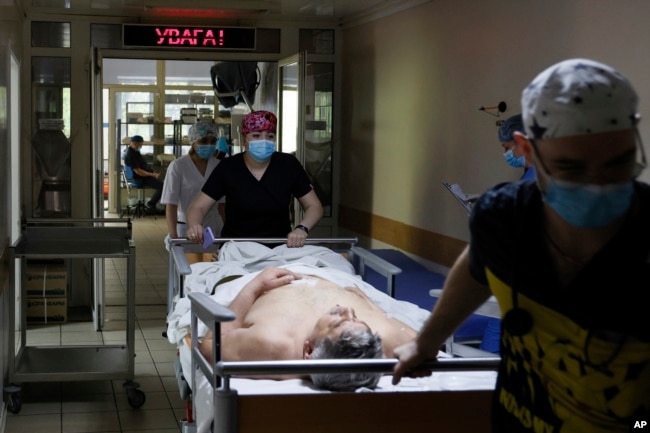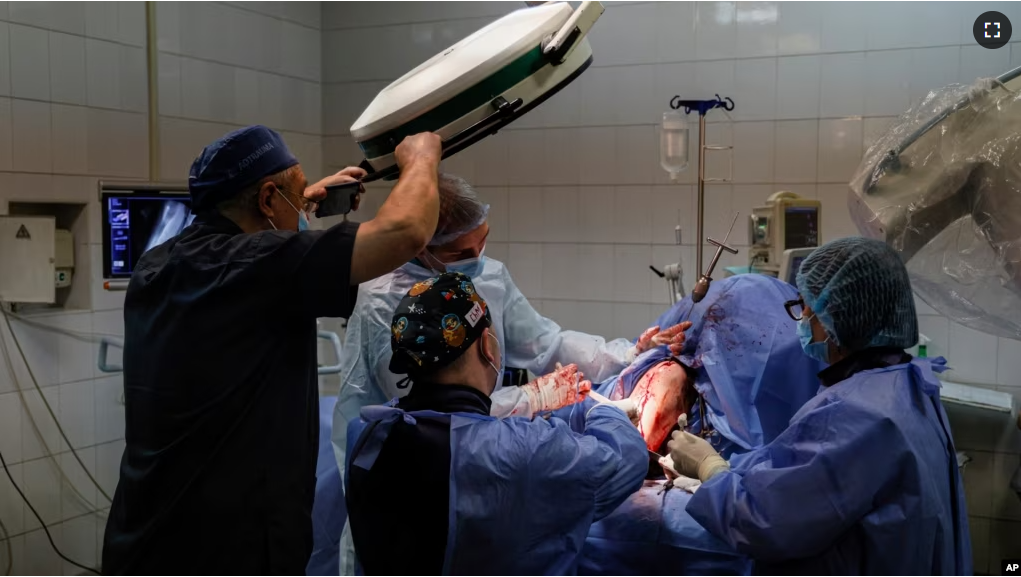Petro Nikitin is the lead trauma surgeon at a military hospital in Ukraine’s capital, Kyiv. The 59-year-old doctor works to repair the bodies of some of the most badly injured soldiers.
“I only operate,” Nikitin said as his team continued surgery on a patient. “I do nothing else in my life now.”
Nikitin said he lives by himself because his wife and children have left the country.
Experts estimate more than 100,000 Ukrainian troops have been killed or wounded since Russia invaded the country almost 15 months ago.
Fighting has been very fierce in recent weeks around the eastern city of Bakhmut. It is the war’s longest and bloodiest battle. Ukrainian forces recently took back more territory from the Russians.
A major Ukrainian counteroffensive is expected in coming weeks. More people are likely to end up in Nikitin’s hospital.
Like other Ukrainian military hospitals, it lacks enough workers because doctors were pulled away to work in field hospitals closer to the fighting. The Associated Press agreed not to identify the Kyiv hospital for security reasons.
The day after Russian troops invaded, Nikitin organized an online training on combat-related injuries.
“Every one of us had relevant experience before the invasion, but not in such volume,” Nikitin said.
But during the war, he has become familiar with a range of serious injuries. Explosive weapons often harm many parts of the body at the same time.
“We receive people with damaged legs, chests, stomachs and arms all at once,” Nikitin said. “In such cases, we have to decide what part of the injury should be our priority.”
The military hospital is one of several in Kyiv. As a top-level trauma center, it receives the most complex cases.
“We don’t save lives. That’s done by the medics,” he said. “What we try to do is return these people to a normal life.”
The most difficult wounds are ones that involve damage to soft tissue, bone and the structures that connect nerves and veins, Nikitin said. Sometimes they are forced to remove a soldier’s arm or leg. He said the decision to remove a body part is always very difficult.
Nikitin usually gets to the hospital at 7:45 in the morning. He stays until the work is done. Sometimes he does not leave until 11 at night.
Russian and Ukrainian armies are both preparing for possible spring offensives. So Nikitin’s work schedule has lightened to about three surgeries a day.

Nikitin recently operated on a soldier named Mykyta. He is from Bakhmut. He was wounded in the lower leg while fighting for his hometown.
“It’s the city where I spent my childhood, and the city is destroyed,” he said from his hospital bed.
Compared with the trauma suffered by some patients, Mykyta’s wound did not look so severe. But he still might lose his lower leg, Nikitin said.
Attempts to graft skin over the wound were unsuccessful. Doctors recently tried again.
Nikitin said he felt hopeful after Mykyta’s surgery. But he added it would take three weeks to know whether the latest skin graft worked.
Mykyta is also missing 20 centimeters of bone, which Nikitin will need to deal with if the graft is successful. The bone treatment will take more than half a year.
“In seven months, I can tell you if he will ever walk again,” Nikitin said.
I’m Dan Novak.
Dan Novak adapted this story for VOA Learning English based on reporting by The Associated Press.
_________________________________________________________
Words in This Story
trauma — n. a serious injury to a person’s body
surgeon — n. a doctor who performs operations that involve cutting into someone’s body in order to repair or remove damaged or diseased parts
combat — n. active fighting especially in a war
relevant — adj. relating to a subject in an appropriate way
volume — n. an amount of something
priority — n. something that is more important than other things and that needs to be done or dealt with first
medic — n. a member of the military whose job is to provide emergency medical care to soldiers who have been wounded in battle
schedule — n. a plan of things that will be done and the times when they will be done
graft — n. a piece of skin, muscle, or bone that is attached to a part of the body to repair a damaged area
